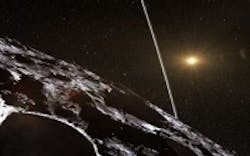Telescopes help identify first ring system around minor planet
Astronomers using telescopes at seven different locations were able to identify two dense and narrow rings around the remote asteroid and minor planet Chariklo, making it the first ringed minor planet ever discovered.
Among the telescopes used to observe Chariklo were the TRAPPIST and the 1.54-meter Danish telescope at the La Silla European Southern Observatory (ESO) location in Chile. The TRAPPIST telescope’s camera, the TRAPPISTCAM, is an FLI ProLine PL-3041-BB with a 2,048 x 2,048 back-illuminated CCD array and 15 µm x 15 µm pixel size from Fairchild Imaging.
On the 1.54-meter Danish telescope, the camera features a 2,048 x 2,048 Loral/Lesser, thinned CCD array with a 15 µm x 15 µm pixel size. Both the 1.54 Danish and the TRAPPIST telescope are also equipped with a number of imaging filter wheels.
The rings of Uranus and the ring arcs around Neptune were discovered in similar, unexpected fashion in 1977 and 1984, respectively. As it stands now, the scientists have not identified an origin of these rings, but one theory, as suggested in an ESO press release, is that they may be the result of a collision that created discs of debris. With these findings—which were published online in the journal Nature—only five bodies within our Solar System have ring systems: Chariklo, Jupiter, Saturn, Uranus, and Neptune. Their discovery, according to Felipe Braga-Ribas, Observatório Nacional, came unexpectedly.
"We weren’t looking for a ring and didn’t think small bodies like Chariklo had them at all, so the discovery—and the amazing amount of detail we saw in the system—came as a complete surprise!” he said in the press release.
Chariklo is approximately 155 miles in diameter and more than three quarters of a billion miles from Earth. In addition to the two aforementioned telescopes, event observations were also performed by the following observatories:
- Universidad Católica Observatory (UCO) Santa Martina operated by the Pontifícia Universidad Católica de Chile (PUC)
- PROMPT telescopes, owned and operated by the University of North Carolina at Chapel Hill
- Pico dos Dias Observatory from the National Laboratory of Astrophysics (OPD/LNA) – Brazil
- Southern Astrophysical Research (SOAR) telescope
- Caisey Harlingten's 20-inch Planewave telescope
- R. Sandness's telescope at San Pedro de Atacama Celestial Explorations
- Universidade Estadual de Ponta Grossa Observatory
- Observatorio Astronomico Los Molinos (OALM) — Uruguay
- Observatorio Astronomico, Estacion Astrofisica de Bosque Alegre, Universidad Nacional de Cordoba, Argentina
- Polo Astronômico Casimiro Montenegro Filho Observatory
- Observatorio El Catalejo, Santa Rosa, La Pampa, Argentina
View the press release.
Also check out:
Images captured by Cassini spacecraft may show ocean waves on Titan
NASA telescope observes evidence of creation of the Universe
Hubble captures image of mysterious disintegrating asteroid
Share your vision-related news by contacting James Carroll, Senior Web Editor, Vision Systems Design
To receive news like this in your inbox, click here.
Join our LinkedIn group | Like us on Facebook | Follow us on Twitter | Check us out on Google +
About the Author

James Carroll
Former VSD Editor James Carroll joined the team 2013. Carroll covered machine vision and imaging from numerous angles, including application stories, industry news, market updates, and new products. In addition to writing and editing articles, Carroll managed the Innovators Awards program and webcasts.
